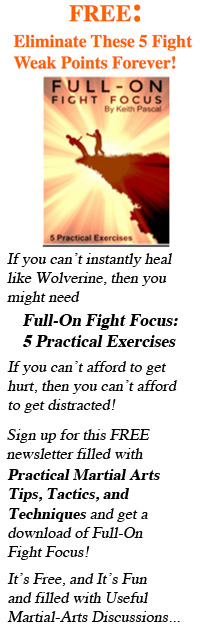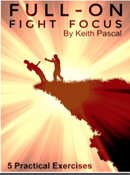Add an Extra Beat
Extra Beat
I just finished reviewing a magic video for a famous magician. In his video, he talks about the rhythm in the revelation of the effect. Immediately, I saw a martial-arts connection….
In the trick, there are really two effects taking place at the end. Two effects equals two beats, right?
Not so fast.
Aaron F. cleverly adds an extra beat. He wants to make sure that the audience’s brains register that something has happened, before he hits them with the second effect, the “kicker.”
Think about it. He adds an extra beat, so that the visual magic doesn’t get muddled.
Can you apply this to your martial arts?
If you want to make sure that someone reacts to one of your moves in a sequence, say an ABC series (See my Free Youtube video on the The Five Ways of Attack http://www.youtube.com/watch?v=s0APq4ZGvF0 ), then this might be your best strategy.
In the video (ABC section), I talk about emphasizing one beat in the rhythm. What if, after one of the main punches or kicks, you added a small pause before hitting or kicking with another aggressive move?
This started the brain juices flowing….
Article Comparisons
I grabbed a copy of the new ebook on the product launch (100 Practical Martial-Arts Articles — check your email for a link or find it on this site in martial-arts bargains). And I immediately started rereading the articles with the idea of adding an extra beat between moves.
After the first 30 articles, I looked at my notes:
I did NOT find it worthwhile to use the concept with articles 7, 14, 15, and 19. Article #18 seemed more promising, but only as a way to get to the headlock. Number 28 was also only mildly interesting, because I rethought “targets.” Not much there.
~BUT~
For those of you who have bought the new ebook (and the bonus on Pressure Points), I think you’ll find a way to incorporate an extra beat into articles 8, 9, 10 (maybe), 11, 12, 13, 16, 21 (for punches), and 22 (for stop kicks).
In addition, I started thinking if I could improve on the leg sweeps in article #29 with an added beat.
It’s important for you to be able to make these types of connections by considering a different principle combined with a martial-arts tip. So, I’ll let you peruse articles 30 – 100, and the 10 pressure-point articles, to brainstorm your own new ideas.
Today, rethink the rhythm of what you’re practicing. Do this if you are a beginner; do this if you are more advanced. We can talk about how people react to pauses, next time.
Good luck,
Keith
PS The introductory offer is still going for the ebook. Check your other emails.
Tags: extra beat, martial arts rhythm, martial arts tactics, martial-arts practice, pauses, progressive indirect attack, strategy, tactics, timing



Great article Keith! I actually learned a little about this a few years back from a boxer. I was lucky enough to Meet John Tate and his Coach Ace Miller at a tournament to honor our local Boys and Girls Club. He suggested that I add a beat to my fake, such as using a double left right combo fake, or two beat fake with the back hand and so forth. I had forgotten a lot of that advice and will check the 100 articles for myself to see where I can relearn that habit. Thanks for the tip and the reminder!
So is this like a stutter? An extra little move to direct my attacker’s attention elsewhere?
Rick
OK. Or a pause. Think of you moving; your opponent hasn’t quite responded
yet … so you add your stutter and then go into the next move in your
combination.
I remember doing hubud with an experienced MA, I was concentrating on
hitting the beats and he was hitting me on the beats and inbetween the beats.
Keith, with this beat, aren’t we getting away from JKD.I have been following Bruce Lee for a Long time and i don’t think he would use this.but I have been wrong before. Just a thought. Correct me if i’m wrong.But don’t get me wrong. i have been following you for quiet a while and i believe in you. So thanks for all the info. I have learned a lot from you.
Interesting idea. Here is another, along those lines.
There is often a ‘natural’ pace to combinations. and other attack techniques. Instead of forcing them to fit into a beat pattern, one can find the natural spaces provided by the distance traveled of the attacking limbs to intended target(s). Beat patterns may also contain single, double, triple or more techniques, withing a single beat.
Wow … great, thought-provoking responses. I hope others are finding this blog. If you’ll pardon some humble suggestions and reactions to the last few posts:
1. Mas — Try playing a hubud game (really an exercise), with your in between
idea … every time your opponent pivots your hand to the side (either side),
you interrupt the timing, by driving straight into the center … use that in-between beat.
2. I can see how many would use this to, unfortunately, slip into a more
inefficient mode, Jesse. So, in that sense, you are right. But …
I have seen Bruce Lee use this (for example, against Dan Inosanto
in the Game of Death (John LIttle version).
It has many applications. Here’s one straight from the Bruce Lee “playbook”
(in other words, I was taught this by Steve Golden). As a demonstration,
I strike toward the face; the opponent blocks upward. On the next
beat, you strike for the stomach; with the same blocking hand, the opponent checks downward, to block.
You continue this alternating up and down with your punches. He or she blocks up and then down. EXCEPT … on one of those punches, you execute two in a row on the same path … like two in a row up top, to the face.
If your opponent is in your rhythm, then he’ll be blocking “down,” when you
are hitting the second “up.”
The works because of the preceding beat.
So, 90% of the time you want to get there as fast and efficiently as possible.
BUt occasionally, you might have to add in a beat, to be able to get to
your run of straight blasts.
3. And finally to the Grubemeister … thank you very much for sharing. If someone unpacks what you really just said and figures out a way to train for it, then you really have provided some “hidden gems of martial arts.”
(The name of this site.)
Thanks again for the comments. Feel free to keep posting. I am not intending to close the topic by jumping in.
Keith
Now i understand what you are talking about Keith. Thanks for the Info.